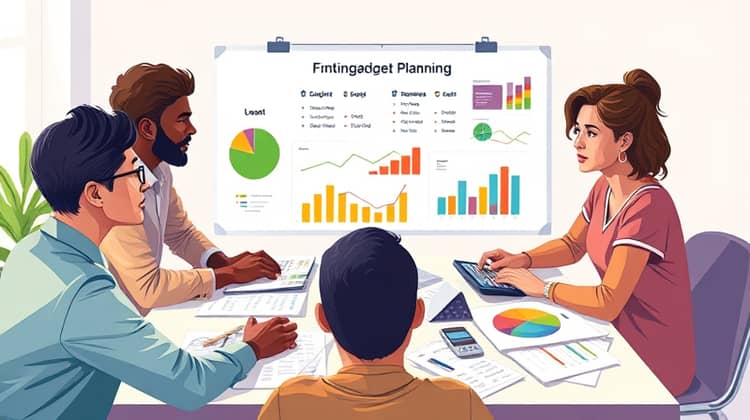Understanding Loan Payments: Breaking Down Principal and Interest

Loan payments are a crucial aspect of borrowing money, whether it's for a home, a car, or any other purpose. Understanding how loan payments work will empower you to make better financial decisions, ensuring that you remain on top of your obligations without jeopardizing your financial health. This article will break down the main components of loan payments, focusing on principal and interest to clarify how these elements interact and affect your overall repayment plan.
Principal can be thought of as the foundation of your loan. It refers to the original sum of money borrowed, which is paid back over time. On the other hand, interest is the cost of borrowing that principal amount, calculated as a percentage. Knowing how these two components affect your monthly payments will help you manage your loans and minimize your overall interest costs.
We'll explore concepts like loan amortization, which dictates how your payments are structured, as well as tips for managing your payments effectively. By the end of this article, you will have a clear understanding of how to navigate the world of loans and become savvy at managing your financial commitments.
The Basics of Loan Payments

When you take out a loan, you enter into an agreement to borrow money that you'll pay back with interest over a set period. This arrangement can seem daunting at first, but understanding the basic components of loan payments can empower you to make informed decisions. Each month, your payment is typically divided into portions that cover both the principal and the interest you owe.
Your principal is the actual amount of money you borrowed; it does not include the interest fees. Interest, on the other hand, is what the lender charges you for the privilege of using their money. The ratio of these components in each payment can change throughout the term of the loan, leading to a strategy known as amortization.
In essence, a loan payment consists of these two primary components – the principal and the interest. The way they interplay affects how quickly you pay down your debt and how much you'll end up paying over the life of the loan.
Principal: The Heart of Your Loan

Understanding principal is vital since it is the cornerstone of any loan agreement. When you borrow money, the principal represents the amount that you must return to the lender. A smaller principal typically leads to lower monthly payments, making your loan more manageable.
However, it’s important to note that the total amount of principal influences both your repayment timeline and the amount of interest you will pay throughout the loan. In most loans, particularly mortgages, your initial payments will consist of a higher percentage allocated to interest rather than principal. This means that at the beginning of your loan, you are primarily paying off the cost of borrowing rather than reducing the amount owed. By knowing how this works, you can better project your payment obligations.
- Principal payments ensure that you are making progress on your loan balance.
- Paying down the principal faster can save you money in interest over time.
- Most loans follow an amortization schedule showing how each payment breaks down.
Recognizing how to manage and accelerate your principal payments can lead to substantive savings and a significant reduction in your loan term.
Interest: The Cost of Borrowing

Interest is essentially the fee charged by the lender for providing you with the loan. It can be calculated in different ways but is most often represented as an annual percentage rate (APR). This rate can vary significantly depending on the type of loan, your creditworthiness, and prevailing economic conditions.
The higher the interest rate, the more you will ultimately pay over the life of the loan. Understanding how interest affects your monthly payment can be crucial for planning your financial future. As you make payments, the interest portion usually decreases while the principal portion increases, especially in amortized loans.
- Fixed interest rates remain constant throughout the loan term, making budgeting easier.
- Variable interest rates can change over time, affecting your monthly payments and overall payment schedule.
- Understanding how interest is calculated can help you negotiate better terms with lenders.
Being aware of how interest impacts your loan can guide your decision in choosing between loan options and help you budget effectively for future repayments.
How Principal and Interest Work Together

The relationship between principal and interest is fundamental to understanding your loan payments. As you begin to pay off your loan, the interest calculations are based on the remaining principal. This means that the more principal you pay down, the less interest accrual you will face.
Over time, as your principal decreases with each payment made, the interest accrued on the lower principal results in higher portions of each installment being put towards paying down the principal. This creates a snowball effect where the loan balance reduces more significantly as you progress through the payment term.
The combination of principal and interest creates your total monthly payment amount, which is crucial for maintaining your budget since these payments are consistent over the life of the loan unless you refinance or increase your loan amount.
Loan Amortization: The Payment Schedule

Loan amortization is a crucial aspect of how loans function, dictating the way payments are scheduled over time. This process breaks down loan payments into equal installments, which consist of both principal and interest components, allowing borrowers to predict how their loan will evolve over its term.
Each scheduled payment is calculated to ensure that by the end of the loan period, the total principal has been repaid, alongside the interest incurred over time. Amortization schedules can vary based on the type of loan, the amount borrowed, and the interest rate but always have the same goal: to fully repay the loan by the end of the term.
Understanding your amortization schedule can help you grasp how much you owe and how your payments will change over time, equipping you with the knowledge necessary to manage your finances efficiently.
Why Understanding Principal and Interest Matters

Understanding the dynamics of principal and interest can empower you to make informed financial choices. By knowing how these elements work, you can better assess the implications of taking on a loan, whether it’s short-term or long-term. Understanding these concepts holds the potential to save you money on interest, allowing you to allocate funds more strategically.
Furthermore, it can help in deciding on loan types: fixed versus variable rates, consolidating loans, or even making extra payments towards the principal. Armed with this knowledge, you can create a more sustainable financial plan that works for you.
Ultimately, an informed borrower is a smart borrower, and understanding these fundamental aspects will lead to broader financial literacy and confidence in managing your loan obligations.
Tips for Managing Loan Payments

Managing loan payments effectively requires a proactive approach to your finances. Implementing a budget that accounts for your monthly loan payments ensures you are always prepared when payment due dates arrive. Creating a dedicated savings account for your loan payments can also serve as a buffer in case unexpected expenses arise, preventing late payments.
Additionally, regularly reviewing your loan terms and interest rates can provide insights into potential savings. If you find that interest rates have dropped since you took out your loan, it may be worth considering refinancing as a way to reduce your payments.
- Establish a budget that accounts for all monthly expenses, including loan payments.
- Set up automatic payments to prevent late fees and keep your credit score intact.
- Consider making extra payments towards your principal to reduce total interest paid.
By implementing these strategies, you can stay ahead of your loan obligations, saving money and reducing stress over time.
Conclusion

Understanding loan payments involves more than just knowing you owe a certain amount each month. By breaking down the components of principal and interest, you gain insights into how loans function and the most effective ways to manage them. This knowledge translates into smarter financial planning and budgeting.
Remember that principal is the amount you borrow, while interest is what you pay for the privilege of borrowing that money. Balancing these two elements is essential to maintaining good financial health throughout the life of any loan. With the right strategies, you can minimize your borrowing costs and understand the journey of repaying your debts more effectively.
Lastly, as you move forward, remember that every financial decision should be made with fullest knowledge and understanding of its consequences. Proactive management of your loans will pave the way for better financial stability now and in the future.






